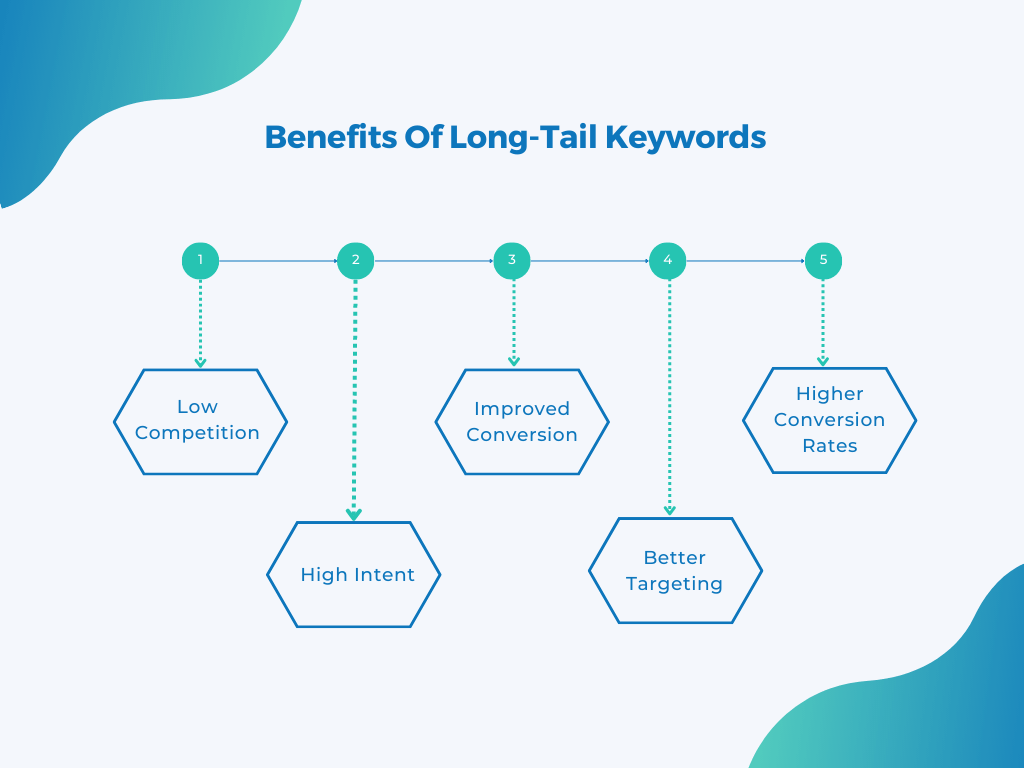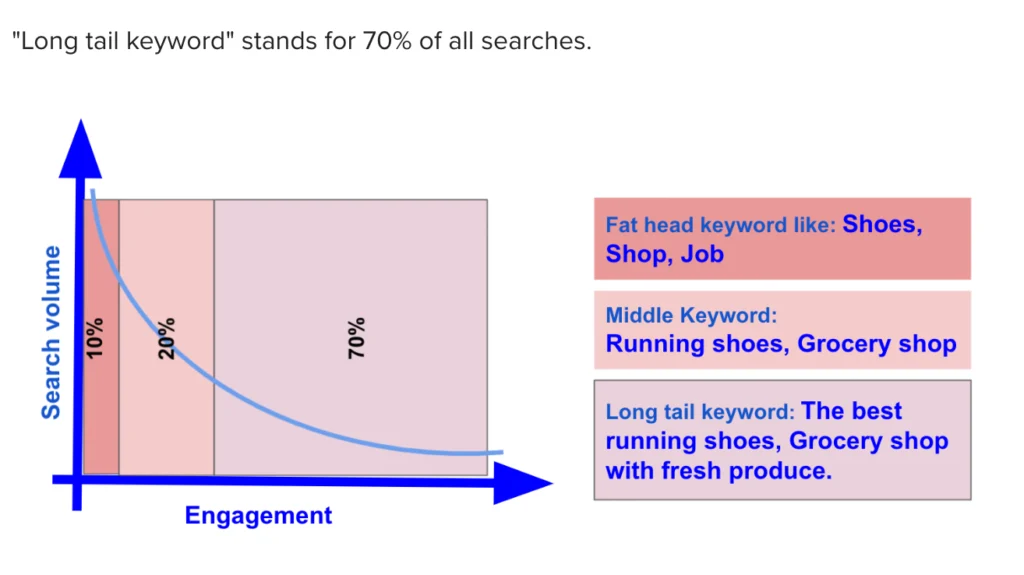Understanding the Fundamentals of Long-Tail Keywords
Keyword strategies have always been the operative word when it comes to generating organic traffic within the closeness of the search engine optimization dynamic. Short-tail keywords are too competitive and thus can hardly be ranked; long-tail keywords are those that open avenues through which a business can easily draw highly targeted traffic through very specific search intent.
The purpose of this guide is to familiarize you with what long-tail keywords are, what benefits they forthcoming bring, how to incorporate them into your SEO strategy for maximum results and how to find long-tail keywords.
What are Long-Tail Keywords and Why Do They Matter?
Long-tail keywords are keyword phrases that contain 3 or more words and are pretty specific to a certain niche. These keywords normally have low search volumes, but because they target a specific intent of users, they lead to higher conversion rates.

Instead of using a broad term like “laptops,” one long-tail keyword may be “best budget laptops for students 2025.” Although it gets searched for less often, it can aid in really zeroing in on a very particular group of people- they’re students who are looking for an affordable laptop in 2025 compared to the much broader, higher-surge search term.
Why Long-Tail Keywords Are Essential:
- Higher Relevance: Since these keywords are highly specific, they align closely with user queries, making content more relevant.
- Less Competition: Broad keywords are saturated with competitors, while long-tail keywords face lower competition, making them easier to rank for.
- Better Conversion Rates: Users searching for long-tail keywords often have strong intent, meaning they are more likely to take action, whether that’s making a purchase, subscribing, or signing up for services.
- Supports Voice Search Optimization: As more users rely on voice search via smart devices, queries tend to be conversational and longer, making long-tail keywords crucial in optimizing for voice search.
The Strategic Advantage of Long-Tail Keywords in SEO
Long-tail keywords play significant roles when optimizing your SEO strategy, and it has several benefits that can increase your search rankings and website traffic. Some good advantages include:-

1. Targeting Niche Audiences:
Long-tail keywords help businesses draw in their niche audiences by addressing unique problems and discoveries. For instance, for an e-commerce shop selling organic skincare, a keyword could be “best organic face cream for sensitive skin” instead of just “face cream”.
2. Enhancing Content Marketing Strategy:
The effective targeting of long-tail keywords can create blog posts, product descriptions, and FAQs so users can easily find answers to their queries. It not only engages them more but also helps to establish their authority in the niche.
3. Competing Against Larger Brands:
Long-tail keywords even the field wherein small businesses and startups can compete with big corporations that dominate short-tail keywords. These enable smaller firms to rank highly with users who search for less convenient yet better-qualified key terms.
4. Boosting Local SEO:
Make their entries run as short-tail entries that are something like that of “best restaurants” instead of forcing entry; local businesses can simply optimize the keyword phrase into the long-tail format that would state “best vegan restaurant in downtown LA.”
Gain a Competitive Edge in Search Engine Rankings
How Long-Tail Keywords Improve Search Rankings:

- Thus reducing competition for keywords: Such longer keywords have less competition compared to short, broad keywords; consequently, getting the first few sites on the SERPs is easier.
- Increased Click-through Rates: These keyword phrases tend to connect users to more specifically related search results, prompting them to click on the most relatable links.
- Gain more Organic Traffic over Time: Well, these are lower search volume terms, but those are the ones that are usually very strong, bringing steady high-quality traffic with time.
How To Find Long Tail Keywords For SEO Strategy
Long-tail keyword strategy relies on proper keyword research. Here is another step-by-step set of keyword strategies To Help You How To Find Long Tail Keywords.

1. Understand Your Target Audience
Your first step when searching for long tail keywords is to figure out your audience’s problem, preferences, and search behavior and use analytical tools like Google Analytics and real surveys to find out what these are that your customers are searching for.
2. Use Keyword Research Tools
To find long tail keywords, use SEO tools such as:
- Google Keyword Planner (for discovering keyword search volume and competition)
- Ahrefs & SEMrush (for competitor keyword analysis)
- AnswerThePublic (for uncovering question-based long-tail searches)
- Google Search Suggestions (to find natural long-tail keyword ideas)
3. Analyze Competitor Strategies
Understand the keywords your competitors are ranking for, find keyword gaps, and explore untapped long-tail opportunities that can boost the site rankings.
4. Optimize for Voice Search
Usually, keywords must be elongated without using “weight loss tips,” and instead going through the popular term how. For example: “How to lose weight without dieting” reads more like a voice search query.
5. Monitor Performance & Adjust
Routine checks on keyword positions, traffic, and conversions with the use of Google Search Console and analytics tools are sufficient to constitute an evaluation of success to make strategic changes. Regularly monitoring your keyword rankings, traffic flows, and conversions as well as using analytics tools such as Google Search Console will keep you informed.
Content Creation Best Practices for Long-Tail Keyword Targeting
To maximize the potential of long-tail keywords, follow these best practices:
- Use long-tail keywords in headlines, subheadings, and throughout the content.
- Provide in-depth and valuable information that directly answers search queries.
- Incorporate keyword variations to cover related queries.
- Optimize for semantic search by focusing on context, not just exact matches.
- Ensure readability and avoid keyword stuffing to maintain a natural flow.
How Do You Integrate Long-Tail Keywords Into Your Content?
1. Title Tags & Meta Descriptions: Ensure both your title and meta description are incorporated with that primary long-tail keyword in it, appearing naturally.
2. Headings & Subheadings: Structure your content using long-tail keyword-rich headings to improve readability and SEO.
3. Body Content: Make use of long-tail keywords naturally all through the text while, keeping readability in mind.
4. Alt Texts & URLs: Optimize Images with keyword-rich alt text and image URLs.
5. Internal Linking & Anchor Text: Link to all the relevant pages on your site with keyword-injected anchor-text links.
FAQs: Long-Tail Keyword Targeting
1. What Exactly Are Long-Tail Keywords and How Do They Differ?
They tend to be more specific and filled with intent than you get with direct search phrases containing three or more words. That is what makes it different from the general, as well as large, short-sale keywords.
2. Why Are Long-Tail Keywords Essential for Modern SEO?
They help websites get listed on less competitive searches, improve conversions, and optimize for voice search.
3. How Can You Identify and Research Profitable Long-Tail Keywords?
By exploring and understanding the analytics of SEO tools and investigating search patterns while tapping into user-generated content for insights.
4. Where Do You Strategically Place Long-Tail Keywords in Your Content?
In title tags, meta descriptions, headings, subheadings, body text, image alt attributes, and internal links.
4. How Can You Measure the Effectiveness of Your Long-Tail Keyword Efforts?
Track organic traffic, keyword rankings, CTR, and conversions using analytics tools.
6. What Advanced Strategies Can You Use to Maximize Long-Tail Keyword Impact?
Leverage topic clusters, structured data markup, semantic SEO, and continuous content updates.












